Moritz Roth

Moritz Roth (1839-1914) was a Swiss pathologist.
Roth renowned for his work in pathological anatomy and the history of medicine. After completing his medical degree in Basel in 1864, Roth trained in Berlin under Rudolf Virchow (1821–1902), further refining his skills in microscopic and experimental pathology. His rigorous approach to morphological detail and clear presentation of pathological findings earned him respect across Europe.
Roth’s tenure as professor of pathological anatomy at the University of Basel (1872–1898) marked a period of substantial institutional development. He established a model pathological institute, emphasizing structured teaching, hands-on anatomical dissection, and meticulously curated specimen collections. His commitment to pedagogical clarity and scientific precision laid foundational standards in medical education. Roth was an influential teacher, prioritizing systematic observation, diagnostic reasoning, and technical competence in pathology.
His most acclaimed scholarly contribution, however, came in the realm of medical history. In 1892, Roth published a definitive biography of Andreas Vesalius Bruxellensis (1514-1564), based on rigorous archival work. This monograph remains a landmark in historical medical scholarship. Though Roth’s later critiques of the historiography of Hippocrates and Leonardo da Vinci stirred academic controversy, they also reflected his conviction that medical history should adhere to the same critical standards as the biomedical sciences. He is eponymously associated with Roth spots (1872), which he first observed in the retina of patients with septicaemia. Dr Moritz Roth contributed numerous articles to the European medical journals, along with works on medical history.
Biographical Timeline
- 1839 – Born December 25 in Basel, Switzerland; son of Carl Ludwig Roth, classical philologist and gymnasium teacher.
- 1858 – Began studies in law at the University of Basel; soon transitioned to medicine.
- 1860 – Death of his father and brother Wilhelm, a young Orientalist.
- 1861–1863 – Studied at Würzburg and Göttingen; influenced by Karl Ewald Hasse and Friedrich Henle.
- 1864 – Awarded Doctor of Medicine (summa cum laude) at Basel.
- 1864–1865 – Postgraduate work at the Virchow Institute in Berlin.
- 1865 – Physician during Basel typhus epidemic.
- 1865 – Granted venia docendi in Basel; joined the Medical Society.
- 1866 – Accepted position as assistant to Rudolf Virchow in Berlin.
- 1868 – Appointed first assistant to F. Grohl at Greifswald; habilitated and taught pathology.
- 1870 – Served in a military hospital near Metz during the Franco-Prussian War.
- 1872 – Appointed associate professor (ausserordentlicher Professor) of pathological anatomy in Basel.
- 1874 – Promoted to full professor (Ordinarius).
- 1880 – Oversaw construction of a new pathological institute in Basel.
- 1887 – Albert Dubler joined as assistant, greatly enhancing the institute’s research and teaching.
- 1897 – Dubler resigned due to illness; Roth retired shortly after.
- 1898 – Retired from his professorship.
- 1902–1912 – Lived in Riehen near Basel; later moved to Gottlieben.
- 1912 – Developed symptoms of gangraena senilis; became bedridden.
- 1914 – Died November 4 in Gottlieben.
Medical Eponyms
Roth spots (1872)
Roth spots [aka Litten sign, Litten spots ] Retinal haemorrhages with white or pale centers, associated commonly with subacute bacterial endocarditis, and immune complex mediated vasculitis.
Roth’s original description of his eponymous sign was retinal white spots and separate scattered haemorrhages (retinal red spots) in close proximity to the optic disc in patients with septicaemia.
Moritz Litten (1845-1907) first used the term ‘Roth spot’ in his 1876 article (published 1878) to describe the current understanding of Roth spots, when he observed retinal haemorrhages with a white centre in patients with endocarditis. Sometimes referred to as Litten sign

Major Publications
- Roth M. Untersuchungen über die Drüsensubstanz der Niere. 1864
- Roth M. Über Netzhautaffectionen bei Wundfiebern. I. Die embolische Panophthalmitis. Deutsche Zeitschrift für Chirurgie, 1872; 1(5): 471-484. [Roth spots]
- Roth M. Andreas Vesalius Bruxellensis. Berlin: Reimer. 1886
- Roth M. Quellen einer Vesalbiographie. Basel: Baur 1889.
- Roth M. Aus den Anfängen der Basler medicinischen Fakultät. Basel: Schweighauser. 1896
References
Biography
- Burckhardt A. Professor Moritz Roth. Correspondenz-Blatt für schweizer Aerzte. 1915; 45: 321–331.
- Portrait of Moritz Roth. Universität Basel
Eponymous terms
- Litten M. Uber akute maligne endokarditis und die dabei vorkommenden retinalveränderungen. Charité-Annalen 1876; III: 137-172. (published 1878)
- Singer I, Haneman FT. The Jewish Encyclopedia: a descriptive record of the history, religion, literature, and customs of the jewish people from the earliest times to the present day. Funk & Wagnalls, New York, 1906; 10: 488.
- Khawly JA, Pollock SC. Litten’s Sign (Roth’s Spots) in Bacterial Endocarditis. Arch Ophthalmol. 1994;112(5):683-684
- Lepore F. Roth’s Spots in Leukemic Retinopathy. N Engl J Med 1995; 332:335.
- Fred HL. Little black bags, ophthalmoscopy, and the Roth spot. Tex Heart Inst J. 2013;40(2):115–116.
Eponym
the person behind the name
Doctor in Australia. Keen interest in internal medicine, medical education, and medical history.
BA MA (Oxon) MBChB (Edin) FACEM FFSEM. Emergency physician, Sir Charles Gairdner Hospital. Passion for rugby; medical history; medical education; and asynchronous learning #FOAMed evangelist. Co-founder and CTO of Life in the Fast lane | On Call: Principles and Protocol 4e| Eponyms | Books |
